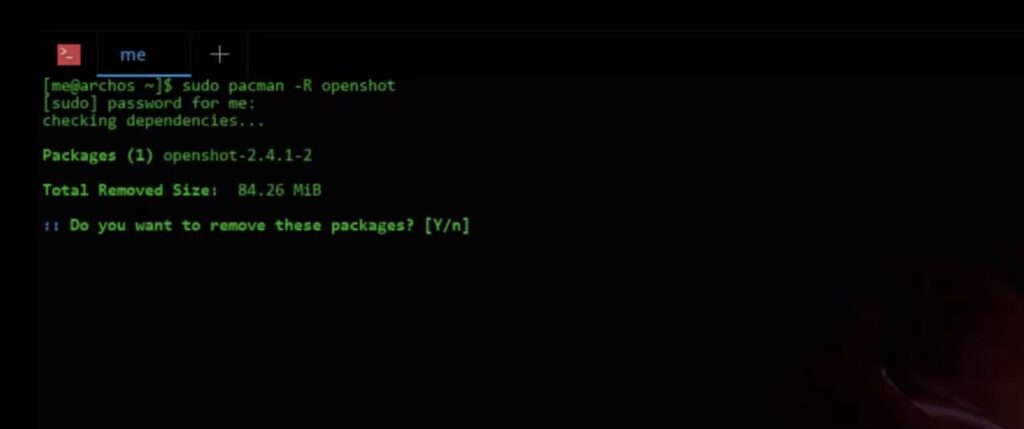In the realm of Arch Linux and its derivatives like Manjaro Linux, Pacman reigns supreme as a robust package manager. It bestows upon users the power to install, update, and manage packages with utmost efficiency. But what about the art of package removal? This narrative shall elucidate the art of parting ways with packages via Pacman and unveil some pearls of wisdom to smoothen and simplify the process.
Uninstalling Packages
To bid farewell to a package using Pacman, one must invoke the following incantation in the third person: “sudo pacman -R [package_name].” The sacred name, [package_name], shall be replaced with the appellation of the package to be disassociated. For example, when the desire to expunge the nano text editor arises, the command shall be invoked thus: “sudo pacman -R nano.”
Pacman, in its wisdom, shall embark upon the journey of removing the designated package along with its faithful companions known as dependencies. When a package serves as a crutch for another, Pacman shall, in its benevolence, ask if the crutch too shall be cast away. In most cases, it is wise to assent, for the crutch loses its purpose when the package that leaned upon it is no more.
Removing Dependent Packages
In the case that a package’s existence hinges upon another, Pacman shall offer a choice: to part with both or retain one. This delicate decision often arises when a user considers the fate of a package and its steadfast companions. However, what if the decree is to sever ties with both the package and its entwined dependencies in a single stroke? Behold, the “pacman -Rs” command, a potent incantation that wields the power to obliterate not only the target package but also its redundant companions.
The syntax is thus: “sudo pacman -Rs [package_name].” To illustrate this incantation’s formidable prowess, consider the case of the nano text editor. Should you desire to bid farewell to nano and its loyal dependencies, the incantation unfolds as follows: “sudo pacman -Rs nano.”
In this mystical world of package management, the “pacman -Rs” command stands as a bold decision, one that severs bonds with both package and dependencies, ensuring a clean slate for your digital realm. With this command at your disposal, you possess the power to sculpt your system with precision, retaining only that which serves your needs while shedding the rest like autumn leaves.
Cleansing the Package Cache
When Pacman ushers packages into your realm, it keeps copies of their essence in its secret cache. This, my friends, is for the day you wish to summon the same package once more, without embarking on the quest for download anew. But beware, for this cache can burgeon and consume precious disk space.
Pacman, being wise, offers a means to cleanse this cache. The “pacman -Sc” command shall purify the cache, retaining only the freshest forms of each package. The incantation is simply: “sudo pacman -Sc.” For those who desire more control, the “pacman -Sc –keep” command stands ready, allowing one to specify the number of cherished versions to retain. To keep the two most recent incarnations of each package, you would intone: “sudo pacman -Sc –keep 2.”
Eradicating Orphan Packages
Orphans, in the world of packages, are those who once served a greater purpose as dependencies but now find themselves bereft, their masters having departed. They linger on, consuming disk space, a burden to the realm. These forlorn packages, once essential to the harmony of the system, now exist in a state of abandonment, their purpose dissolved like mist in the morning sun.
To vanquish these orphaned souls, one beckons the “pacman -Rns” command, a potent spell in the repertoire of a Linux sorcerer. The incantation is scripted thus: “sudo pacman -Rns $(pacman -Qtdq).” This command embarks on a quest to identify and categorize these abandoned spirits, compiling a list of all orphaned packages using the mystical “pacman -Qtdq” incantation. Once this spectral roster is complete, the command’s true purpose unfolds, commanding the removal of these lingering phantoms with the unyielding “pacman -Rns.”
In this grand symphony of package management, the eradication of orphans is a necessary verse, ensuring that the system remains free of unnecessary burdens and clutter. The Linux sorcerer, armed with Pacman and its potent commands, maintains the balance of their digital realm, where only the essential packages find solace, and the orphans are ushered into the void.
Conclusion
Pacman, a mighty package manager, renders the task of installing, updating, and managing packages upon Arch Linux and its progeny an effortless endeavor. The art of package removal is equally facile. Pacman, with its arsenal of commands, ensures that packages and their dependencies can be dispatched with ease. Whether your goal is to liberate disk space or shed unneeded packages, Pacman stands as your unwavering ally.
